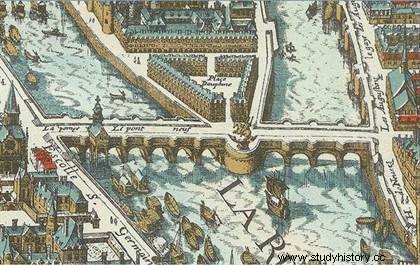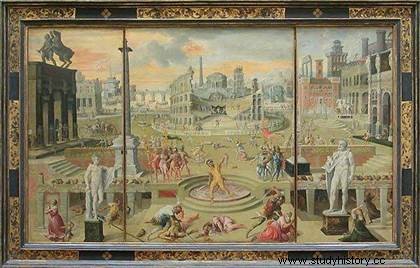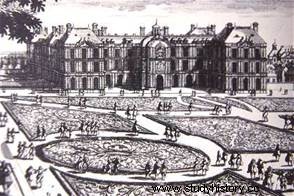 If patronage and relations between the prince and the arts are old, it is often considered that the France of the Renaissance, that of Francis I, is one of the most perfect examples. The castles of the Loire, commissions from the greatest artists of his time, made Valois the ideal patron prince. However, one can ask the question:what happened next, until the advent of an even greater patron prince, Louis XIV?
If patronage and relations between the prince and the arts are old, it is often considered that the France of the Renaissance, that of Francis I, is one of the most perfect examples. The castles of the Loire, commissions from the greatest artists of his time, made Valois the ideal patron prince. However, one can ask the question:what happened next, until the advent of an even greater patron prince, Louis XIV?
Henry II and the arts
Did the death of Francis I in 1547 mean a weakening of the role of the arts at Court, and beyond? His son, Henry II, has other concerns and a number of problems to manage upon his arrival on the throne. He calls Anne de Montmorency back to help him raise the finances that have been hurt by his father's lavish spending. Patronage is no longer the priority, even if the Court continues to be active in the arts, with Catherine de Medici, but also Diane de Poitiers. Admittedly, power still appealed to poets and artists, in particular architects, such as Pierre Lescot (for the Louvre, completed in 1556), Androuet du Cerceau, or Philibert Delorme for the Château d'Anet and the Chenonceau gallery. . Moreover, the prince is always staged, as when entering cities (in Rouen, in 1550, for example). But we no longer reach the importance assumed under François I. The context has a lot to do with it, even more with the religious wars that are coming...
The arts, the religious wars and Catherine de Medici
In the period of crisis that broke out in France in the 1560s, the role of Catherine de Medici was not only political. Indeed, no doubt because of her Florentine origins, the Queen Mother believed in the magical power of the arts during the Civil War. Humanists, such as Jacques Amyot, are put forward and seen as a means of recreating harmony within the kingdom. She was also a great collector, as shown by an inventory of the hotel in rue des Deux-Ecus, established in 1589, after her death. The recorded works would then have been valued at more than five hundred thousand crowns.
 Under the influence of Catherine de Medici is also always built the mausoleum of the Valois at the basilica of Saint-Denis , where Le Primatice would have worked. Artists like the Clouets or Antoine Caron (“Les massacres du Triumvirat ” , a reference to the civil war) are still active, while men of letters such as Montaigne or Ronsard are protected.
Under the influence of Catherine de Medici is also always built the mausoleum of the Valois at the basilica of Saint-Denis , where Le Primatice would have worked. Artists like the Clouets or Antoine Caron (“Les massacres du Triumvirat ” , a reference to the civil war) are still active, while men of letters such as Montaigne or Ronsard are protected.
Finally, in 1570, King Charles IX and Jean Antoine de Baïf founded the Academy of Poetry and Music, based on a Florentine model. This is the first in France.
Henry III and the arts
The political situation of the successor of Charles IX is not the easiest, since he has to face the Calvinists and the "Malcontents". This has an influence on his relationship to the arts.
While he did not have the means for a real patronage policy, Henri III, influenced by Jacques Amyot, believed in the importance of letters and the arts to govern . He thus decides to commission artists to work on his image, to make him a sober and very Catholic king, with wide distribution. Among them, we can mention Germain Pilon or Jean de Court.
The king also encouraged the Academy by creating a council of men of letters and poets, including Jean Antoine de Baïf, Philippe Desportes and Jean Dorat, as well as musicians like Claude Lejeune or Jacques Maudit. This council meets to discuss subjects proposed by the king himself. The lack of means, unfortunately, ends up harming them too, and their work is ultimately in vain.
Indeed, Henry III's desire to control his image backfired as political difficulties mounted. Worse, this image is ultimately desacralized, and the Leaguers do not hesitate to represent it demonized on engravings. His assassination is only a logical consequence of this change of status.
Henri IV the builder
Upon his arrival on the throne in 1589, the Bourbon was mainly concerned with the end of the civil wars and the restoration of peace. He was not really interested in the arts until 1598.

Henry IV proves above all to be a prince-builder, particularly in the capital. After relaunching work in Fontainebleau and Saint-Germain-en-Laye with artists like Toussaint Dubreuil and Jacob Brunel, he tackled Paris to make it a modern city. It is first the Pont-Neuf, then the Place Royale (Place des Vosges), the Place Dauphine, the Saint Louis Hospital, the Porte and the Place de France (projects). In addition, he added the Flore pavilion to the Tuileries, and linked them to the Louvre by a wing which houses the "royal gallery".
From Louis XIII to Louis XIV
The period following the death of Henri IV in 1610 is often seen as a decline, or at least a "stagnation" of the arts, before the explosion under Louis XIV. Once again, the international context plays a role, in particular on finances. And the arts are not so moribund.
Before Louis XIV, three people continued to be interested in the arts, Louis XIII being in the background:Marie de Médicis and Richelieu first, then Mazarin. Baroque art is developing, a consequence of the Catholic reform, which insists on art to accompany faith:the faithful must be amazed in front of the buildings dedicated to God. Thus, the chapel of the Sorbonne, decided by Richelieu in 1635. The cardinal founded the French Academy the same year. He supported painters including Philippe Champaigne and Jacques Stella, asserting himself as the greatest collector of his time.
Marie de Médicis, meanwhile, in her quest for legitimacy following the death of her husband Henri IV, first continued the work of the latter in Paris, such as the Grande Galerie du Louvre, influenced by the Uffizi gallery in Florence . Then there is the Luxembourg Palace, built between 1615 and 1622 on the model of the Pitti Palace, where Marie de Medici had grown up. Finally, the regent surrounds herself with great artists like Rubens (later dismissed by Richelieu).

A man of transition between Louis XIII and Louis XIV, Mazarin also proved to be a collector (including the famous Mazarine library and its 40,000 volumes) and a protector of the arts. In 1647, he introduced Italian opera to France, and a year later he helped found the Royal Academy of Painting and Sculpture. His influence on the future Sun King in this area is manifest, not only for his taste, but also for the importance of the arts in the exercise of power.
The relationship between the prince and the arts therefore remains important between the two great patrons, François I and Louis XIV, despite tense contexts and severely affected finances. Arts protected by the sovereigns themselves, but just as much by the other princes who surround them...and influence them.
Bibliography
- L. Bély, The society of princes (16th-18th centuries) , Fayard, 1999.
- H. Oursel, J. Fritsch, Henry II and the arts:Proceedings of the international colloquium, Ecole du Louvre and National Museum of the Renaissance-Ecouen , French Documentation, 2003.
-J-F. Maillard, I. Conihout de, G. Poirier, Henri III, patron of the arts, sciences and letters , Paris-Sorbonne University Press, 2006.
-J-F. Dubost, Marie de Medici, the queen unveiled , Payot, 2009.
- H.T. Goldfarb (dir), Richelieu. Art and power , catalog of the Montreal-Cologne exhibition, 2002.
- P. Goubert, Mazarin , Fayard, 1990.
